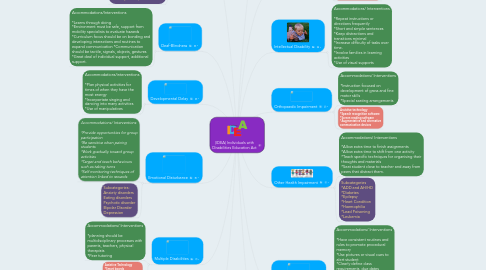(IDEA) Individuals with Disabilities Education Act
Michelle Cheung-kistlerにより

1. Autism
1.1. Accommodations/ Interventions *Use short sentences when giving instructions *Repeat instructions and check for understanding *Use clear language *Use words in addition to gesture and facial expressions
1.2. Assistive Technology *Use of computer based learning (like School of One) *Visual cues for clarity
1.3. Case Study; Hunter
1.4. Subcategories *Autism *Asperger *Rett Syndrome Disintegrative Disorder *PDDNOS (Pervasive Development Disorder Not Other Specified)
2. Deaf-Blindness
2.1. Accommodations/Interventions *Learns through doing *Environment must be safe, support from mobility specialists to evaluate hazards *Curriculum focus should be on bonding and developing interactions and routines to expand communication *Communication should be tactile, signals, objects, gestures *Great deal of individual support, additional support.
3. Developmental Delay
3.1. Accommodations/interventions *Plan physical activities for times of when they have the most energy *Incorportate singing and dancing into many activities *Use of manipulatives
4. Emotional Disturbance
4.1. Accommodations/ Interventions *Provide opportunities for group participation *Be sensitive when pairing students *Work gradually toward group activities *Target and teach behaviours such as taking turns *Self monitoring techniques of attention linked to rewards
4.2. Subcategories: Anxiety disorders Eating disorders Psychotic disorder Bipolar Disorder Depression
5. Multiple Disabilities
5.1. Accommodations/ Interventions *planning should be multidisciplinary processes with parents, teachers, physical therapists *Peer tutoring
5.2. Assistive Technology *Smart boards *Special keyboards such as intelliKeys
6. Speech or Language Impairment
6.1. Accommodations/ Interventions *Speech therapist *Focus on interactive communication *Ensure student has a way to express their wants and needs *Use tactile and visual cues
6.2. Assistive Technology *Use of auditory equipment such as recordings to emulate
6.3. Case study: Dylan
6.4. Subcategories *Fluency disorder *Impaired articulation *Language impairment *Voice impairment
7. Deafness
7.1. Accommodations/ Interventions *Use of visual supports *Use of facial expressions gestures and body language *Make sure student can see your face
7.2. Assistive Technology *Smart boards *Projectors *Sound amplification equipment
7.3. Subcategories *Conductive hearing loss *Sensorneural hearing loss *Mixed hearing loss *Central hearing loss
8. Hearing Imparement
8.1. Accommodations/ Interventions *Use of visual cues and manipulative *Written instructions *
8.2. Assistive Technology *Smart boards *Projectors *Sound amplification equipment
9. Intellectual Disability
9.1. Accommodations/ Interventions *Repeat instructions or directions frequently *Short and simple sentences *Keep distractions and transitions minimal *Increase difficulty of tasks over time. *Involve families in learning activities *Use of visual supports
10. Orthopaedic Impairment
10.1. Accommodations/ Interventions *Instruction focused on development of gross and fine motor skills *Special seating arrangements
10.2. Assistive technology *Speech recognition software *Screen reading software *Augmentative and alternative communication devices
11. Other Health Impairment
11.1. Accommodations/ Interventions *Allow extra time to finish assignments *Allow extra time to shift from one activity *Teach specific techniques for organising their thoughts and materials *Seat student close to teacher and away from peers that distract them.
11.2. Subcategories *ADD and AH/HD *Diabetes *Epilepsy *Heart Condition *Haemophilia *Lead Poisoning *Leukemia
12. Traumatic Brain Injury
12.1. Accommodations/ Interventions *Have consistent routines and rules to promote procedural memory *Use pictures or visual cues to alert student *Clearly define class requirements, due dates *Provide handouts *Use different ways to explain *Break information into small steps
12.2. Assistive Technology *Projectors, to show information in visual context *Recording equipment- to record lessons.
13. Visual Impairment including blindness
13.1. Accommodations/Interventions *Learns through doing *Environment must be safe, support from mobility specialists to evaluate hazards *Curriculum focus should be on bonding and developing interactions and routines to expand communication *Communication tactile
13.2. Case study


